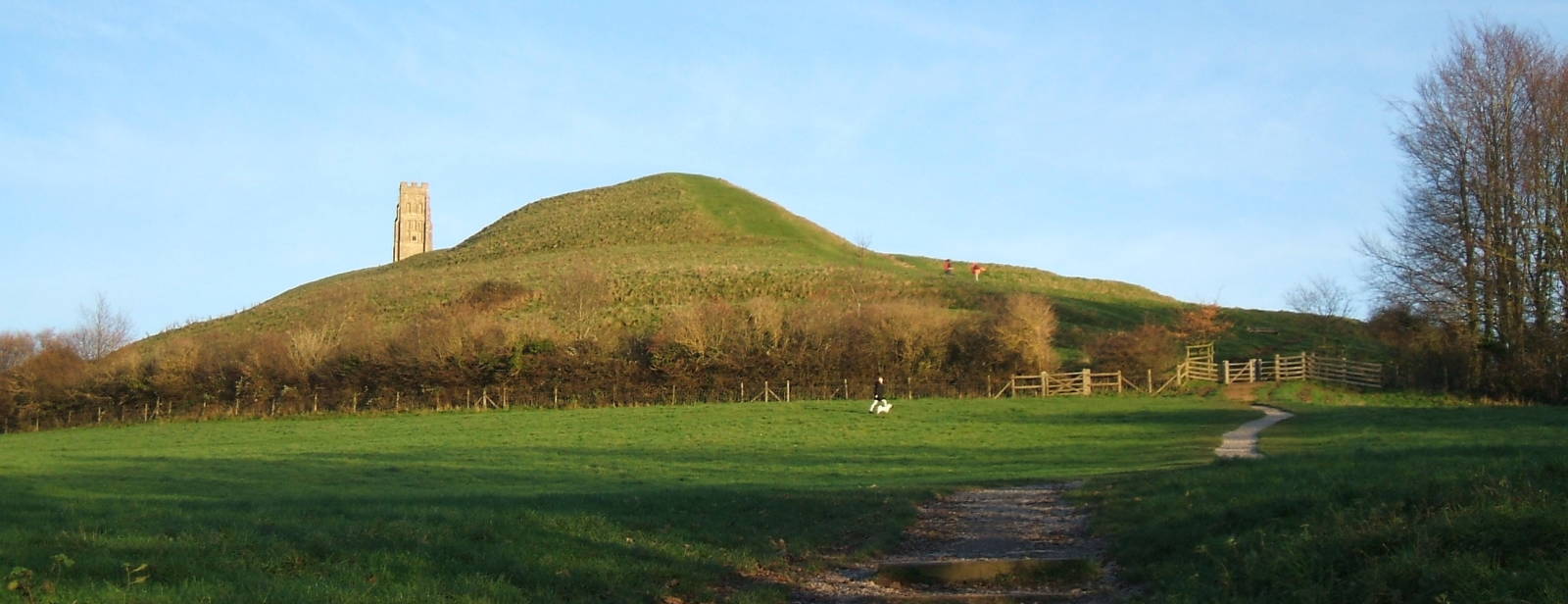
White Spring, Chalice Well and Glastonbury Tor
The White Spring and the Chalice Well
We're visiting Glastonbury, and we've heard the earlist legends about King Arthur and Guinevere. Those led to later and even more speculative legends about Joseph of Arimathea and the Holy Grail. Some of the legends associate the Holy Grail with some springs.
A pair of springs at the base of Chalice Hill have been used for thousands of years.
Although the two springs are within a hundred meters of each other, their outputs differ. The White Spring is a source of almost 95,000 liters of water per day. Its water contains high concentrations of calcium carbonate dissolved as it flows through the underlying limestone. This makes for white calcite deposits.
The water flowing from the Red Spring in the Chalice Well gardens contains dissolved ferrous oxide which leaves red deposits as it precipitates out.
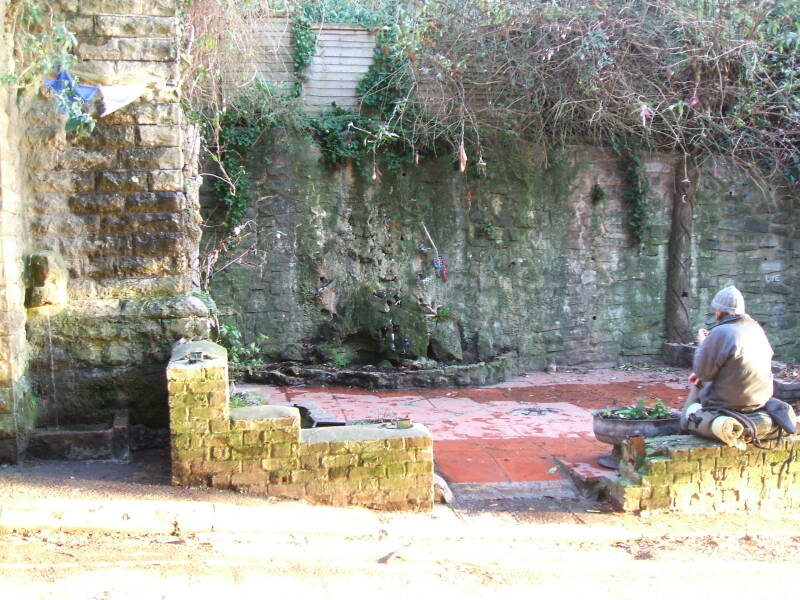
Healing Powers?
The monks of the abbey were more concerned with what they called the Well of Saint Dunstan under the Lady Chapel. The local people used the pair of springs as a practical source of clean water.
With the abbey closed for centuries, the people of Glastonbury started talking about these as holy springs, or at least with water somewhat useful for healing. The talk about curative powers increased until October of 1750, when Matthew Chancellor of North Wootton, about three miles from Glastonbury, announced that he had been healed by its water after having a prophetic dream.
He had been afflicted with asthma and other troubles, and one night after a violent fit of coughing he fell asleep and dreamed that he was standing on a horse track where he saw some remarkably clear water. Someone standing beside him pointed to the water and told him to drink it, in secret, for seven successive Sunday mornings.
He started the following Sunday morning to travel each week to Glastonbury to drink a glass of water from this spring. After the seven-week course he announced that he was cured.
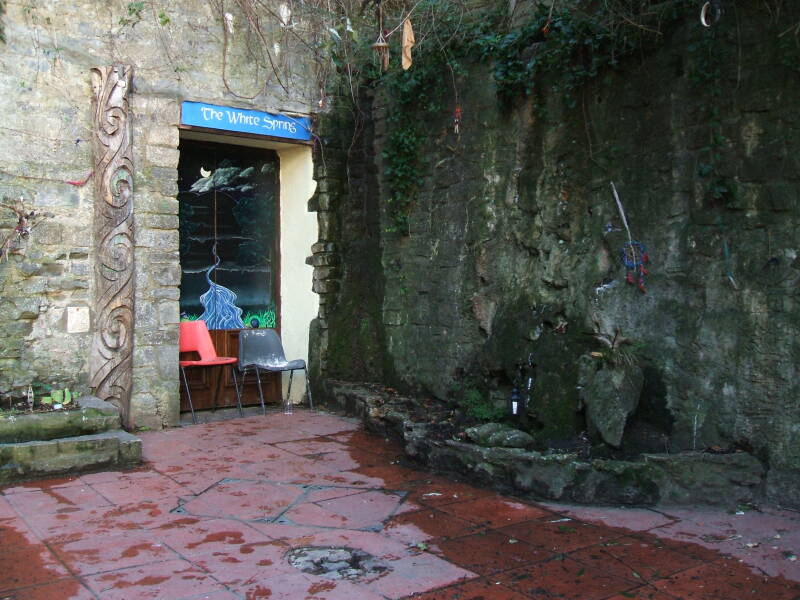
The Gentleman's Magazine reported that on May 5, 1751, ten thousand people came from Bristol, Bath and other areas to Glastonbury to drink the spring water for their health. A pamphlet had been written on the efficacy of the water, and its author declared that the story was true. To persuade those who were still skeptical, "Matthew Chancellor the Dreamer" swore a statement.
Signed, Matthew Chancellor,
Thomas White, Mayor
Attested, R. Blake.
The people of Glastonbury took advantage of this, of course. The water was carefully collected and shipped out in sealed bottles to be sold in apothecaries. A pump-room was built to better get the water to the numerous drinkers. The surge in visitors created a demand for accommodations.
White Spring
White Spring reservoir was set up in 1872 to combat a cholera epidemic. It holds 37,700 gallons, or a day and a half's full output of the spring. The high concentration of calcium carbonate rapidly blocked pipes, and by 1900 water was being piped in from out of town. The city eventually sold off the derelict spring house and reservoir.

Welsh mythology often includes a spring serving as a gateway to the spirit world. The retroactive "discoveries" around Glastonbury thereby associate these springs with figures like Brigit the pre-Roman Celtic fire goddess and guardian of sacred springs. Drink this water and gain her poetic wisdom, metalsmithing skills, and healing abilities, or so they say.
Now the reservoir is set up as a temple space. Candles, dripping water, and hushed voices. Drumming is allowed if it is strictly ritualistic and limited to no more than 15 minutes at the opening and closing of rituals. No mid-ritual drumming, no Grateful Dead improvisation, and no shamanic frenzies.
Red Spring and the Vesica Piscis

Aren't these two overlapping circles just the most amazingly mystical thing you have ever seen?
As for the Red Spring, a well covering featuring two overlapping circles was given to the town as a gift in 1919.
The overlapping circles form the Vesica Piscis symbol, with a sword or spear bisecting the central mandorla or almond-shaped overlap. The intent is that the circles are the overlapping inner and outer worlds and the sword is Excalibur.
Oh, and Vesica Piscis? It means "Fish Bladder".
Frederick Bligh Bond, a church architect and archaeologist, designed the well cover. He said that the cover's design was "typical of many early diagrams, all having the same object — the rendering of spiritual truth by means of the purest, most intellectual system of imagery conceived by the mind, namely, truth which is "aeonial" or eternal, of which geometry is the best interpreter, since it can figure for us with remarkable suggestiveness those formative principles upon which the Father has built his Creation, principles which shall endure when heaven and earth have died."
It gets deeper.
Some say that the overlapping circles are an important symbol from Kabbalism. Some say that Freemasonry discovered and preserved the tradition of overlapping two circles with the center of each on the perimeter of the other. Some go on at length about polarities and symbolism of rebirth and formulae of sacred geometry and harmonious tuning of subtle energies.

Still others, and these seem to be the majority, say that the overlapping circles are a yonic symbol, a reference to the female genitals and thus the feminine aspect of deity. Yoni or योनि is Sanskrit for vagina, you see.
The red tint in the water is said to represent, at the very least, the rust of the nails used in Christ's crucifixion. The further extensions to the legends of Joseph of Arimathea have him depositing some of those nails and the two cruets with the blood and sweat of Christ down the Chalice Well, and some say that the red tint is literally from that rust and blood. The idea is that the cruets are down in the spring, and maybe the Grail itself.
Another view is that the red is the blood of the Mother Goddess Γαϊα or Gaia.

Glastonbury Tor — the लिङ to the योनि
If the Chalice Well is the yoni / योनि symbol, then the corresponding lingam or mystical phallic symbol for the masculine aspect of deity is the nearby Tor. Or so the recent New Age interpretation sees the landscape of Glastonbury. Tor is a Celtic word meaning "hill" or "rock outcropping".
Lingam or लिङ is a representation of the Hindu deity Shiva. There is debate among scholars of Hindu symbolism as to whether the lingam is really meant to represent a literal phallus or if it is a truly aniconic symbol. Unlike योनि or yoni, literally "vagina", the word लिङ or lingam means "mark" or "sign" or "inference".
It's striking that it seems to be mostly English and American anthropologists who insist on a explicitly sexual interpretation of the lingam while actual practicing Hindus see it as an abstraction.
The Tor is a conical hill not looking at all lingamesque in any sense, at least not to me. That tower remaining from the Church of Saint Michael, sure, but that's a very recent artificial addition.
An ancient processional avenue led to the Tor. The two gnarled oak trees called Gog and Magog are thought to be the last remainders of this processional avenue.
The Tor is 158 meters tall. An ancient Celtic legend says that it's the stronghold of Gwyn ap Nudd, the great warrior and ruler of the underworld known as Annwym. Supposedly ancient legends retroactively "discovered" during the 1800s soften his image by insisting that he was primarily a faery king.
The Arthurian angle is that this is the mythic Ynys yr Afalon or the Isle of Avalon where the sword Excalibur was originally forged.
King Arthur was taken here after being mortally wounded by his nephew Mordred in the Battle of Camlann. Britain's "Once and Future King" sleeps here dreaming until the stars align and his country calls again. Ph'nglui mglw'nafh Arthur Tor wgah'nagl fhtagn. "In his house at Glastonbury Tor dead Arthur waits dreaming."
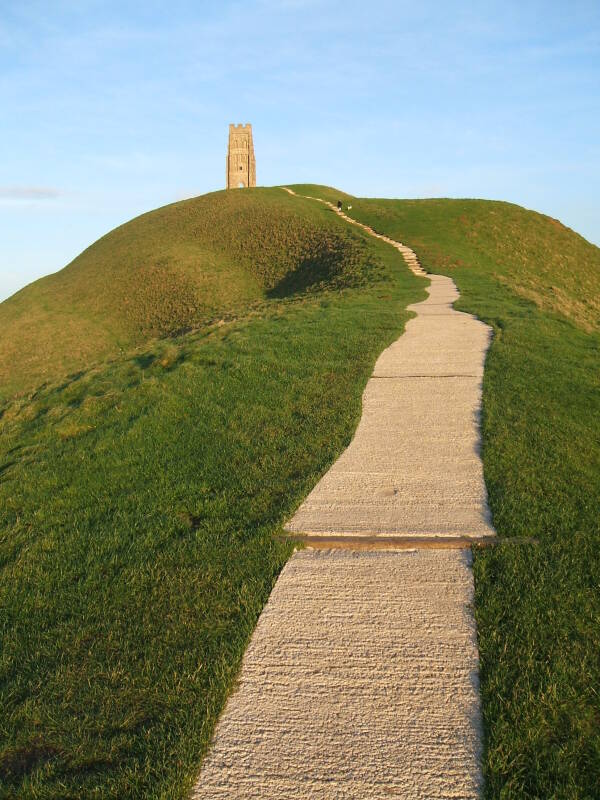
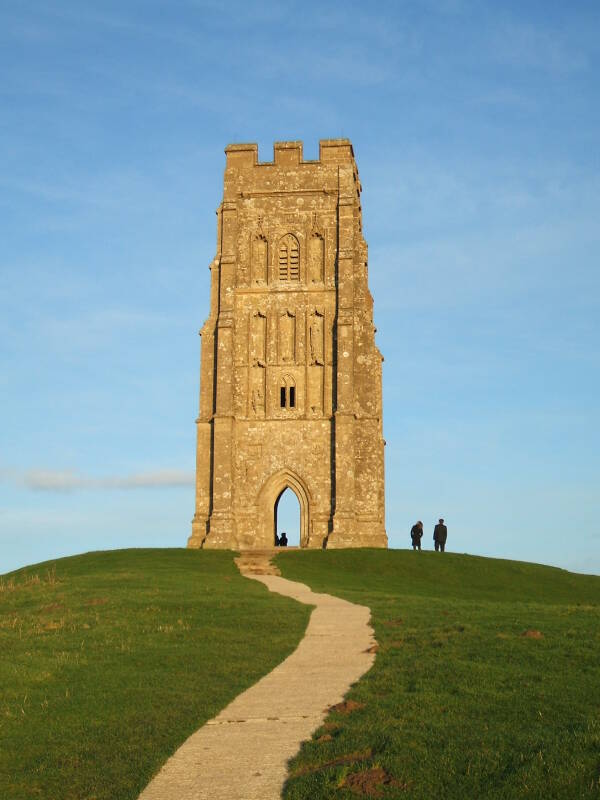
A fort was built at the top of the Tor in the 5th century.
The fort was replaced by Saint Michael's Church in medieval times, but only its tower remains. The church collapsed in 1275, probably due to a landslip as the Tor is a mass of limestone on a sloping bed of clay.
The church came up with a story about a Christian saint Collen, supposedly the Abbot in the 7th century, banishing Gwyn ap Nudd and his entourage with holy water. The church frequently consecrated hill tops that had been regarded as places of heathen gods. The archangel Michael is commonly assigned to hill tops, as in this case.
Meanwhile the Welsh myths had described Gwyn ap Nudd as part of Arthur's forces at times.
Henry VIII had the last abbot of Glastonbury and two of his monks executed up here on the Tor. The abbot, Richard Whyting, and two monks, John Thorne and Roger James, were executed by hanging in 1539. The abbot was then beheaded, drawn and quartered. His head was placed on the abbey gate, and the four sections of his body were distributed to Wells, Bath, Ilchester and Bridgewater.
In 1934 Katherine Maltwood, an artist, said that she had a vision in which she "discovered" the Temple of the Stars, supposedly an enormous map of the astrological zodiac formed in the landscape around Glastonbury with a radius of about 10 miles.
According to Maltwood, the Sumerians had traveled all the way to Britain to build this landscape zodiac in about 2700 BC. Other "researchers" feel that 2700 BC Sumerian construction is far too mundane, and it must have been built much earlier. Unfortunately for their argument, they say it must have been built around 7000 BC but somehow connected to the Dendara zodiac which wasn't created until 50 BC.
This crackpot theory has become increasingly popular ever since it got another boost in a magazine article in 1969.
We're looking down from just part way up the Tor in the picture below. Wearyall Hill is in the distance at left.
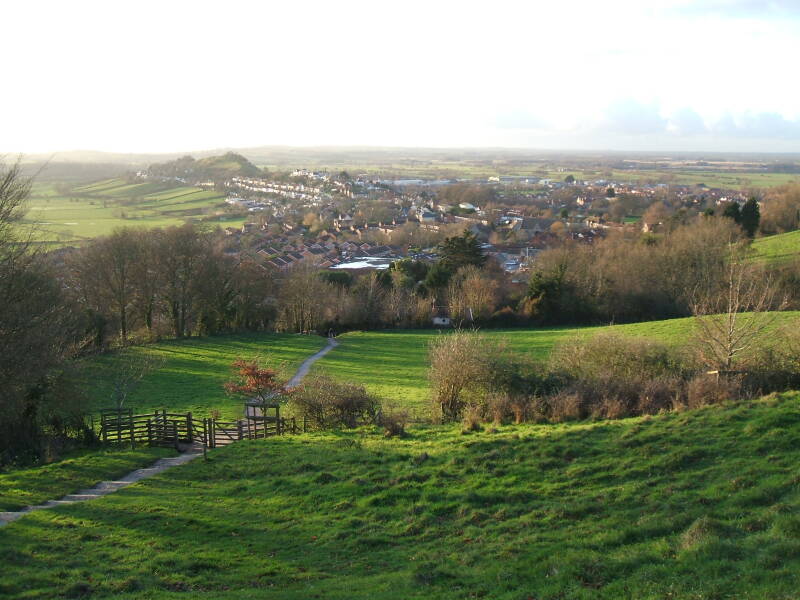
We're looking northwest in this picture, over Glastonbury toward the coast.
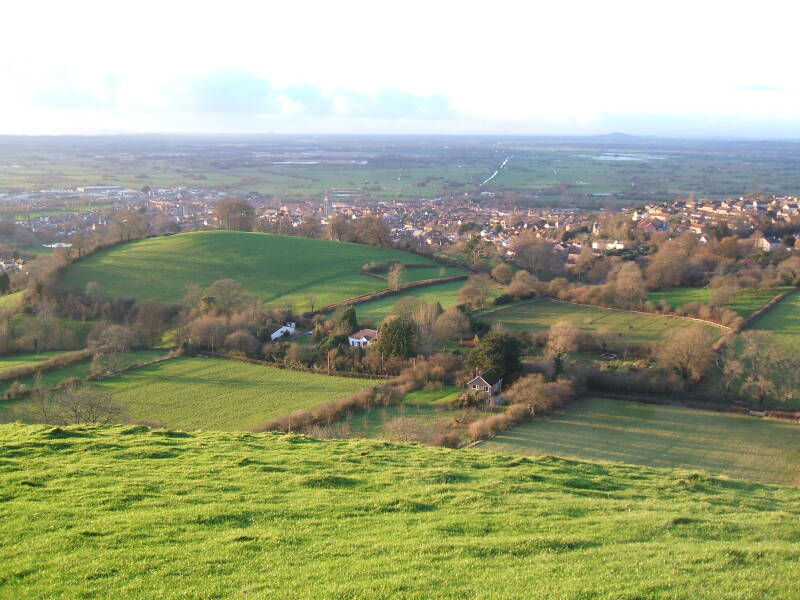
One of the many problems with the strange notion of the Temple of the Stars is the fact that most of the area occupied by the supposed zodiac was underwater in both 2700 BC and 7000 BC. That's why the Neolithic people were building those wooden walkways. By the way, none of the several Neolithic pathways match any of the supposed zodiac features.
The "Eye of Capricorn" was a haystack which happened to be stacked in a useful location in 1934 AD but of course did not date back to the supposed Sumerian project of 2700 BC.
The "western wing of the phoenix of Aquarius" was a road that was constructed in 1782. Maps from the 1620s show no roads or paths along its route.
Cancer is represented by a boat instead of a crab so as to take advantage of some ditches and paths, but those features all date to eighteenth century drainage projects.
Here we are looking northeast toward the Mendip Hills, the northern boundary of the Somerset Levels.
Notice the shadow of the Tor in the distance at the right edge of the picture.
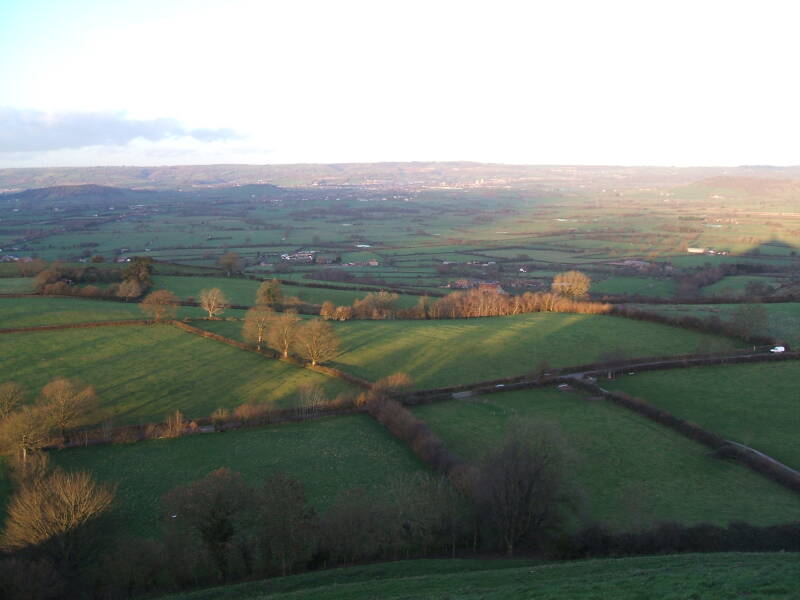
Glastonbury became a center for wool trade in the Middle Ages, and maintained a significant wool market until the 18th century. A Saxon-era canal connecting the abbey to the River Brue was used to move goods.
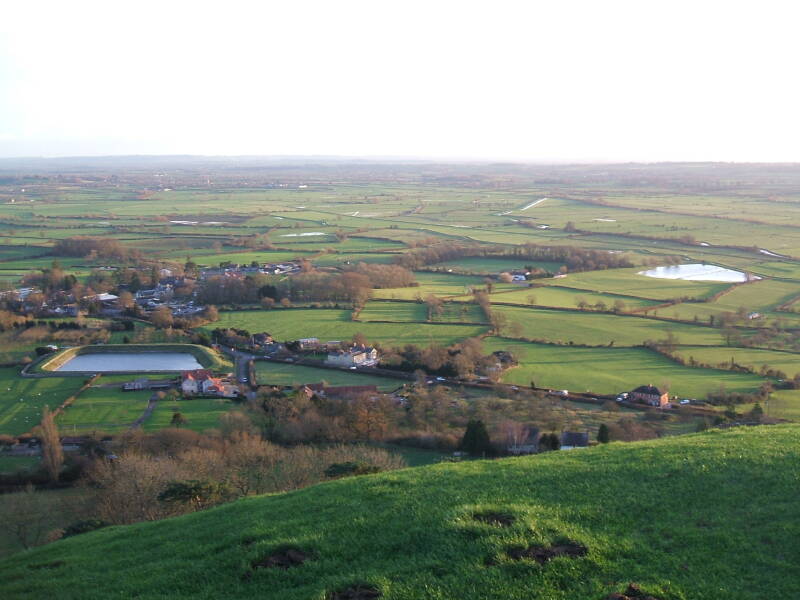
The Glastonbury Canal was needing major reconstruction by the mid 1700s. When the railroads arrived in the 1800s, Glastonbury's economy was depressed. The canal was closed in July of 1854 and the new railway opened the following month. But then the main rail line to Glastonbury closed in 1966.
Now the A39 road is the only way to get to Glastonbury.
The daily bus service between Bath and Glastonbury takes 60 to 90 minutes. It runs infrequently, something like once a day but not at all on Sundays.
Bus number 376 between Glastonbury and Bristol is much more useful, it runs every hour during the day. The First Group bus company's web site has schedules.
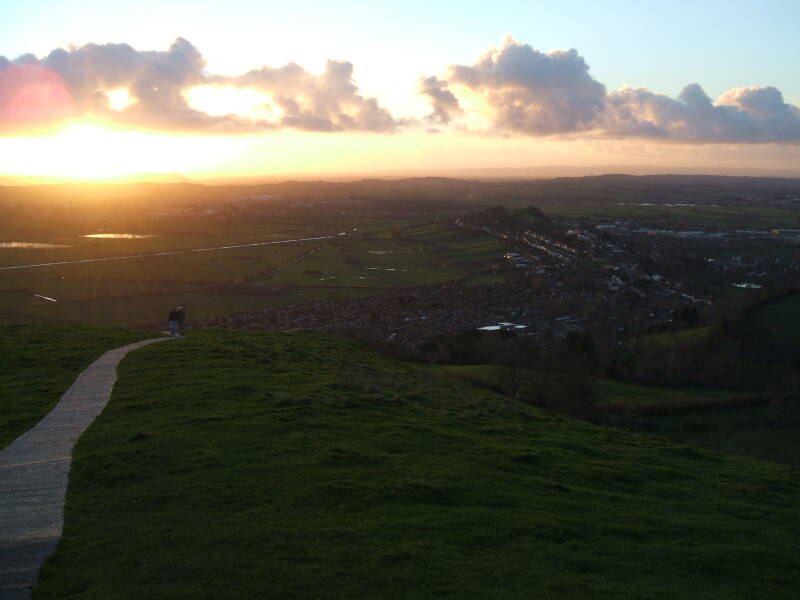
The Sun is setting, let's go back down the Tor and explore Glastonbury.